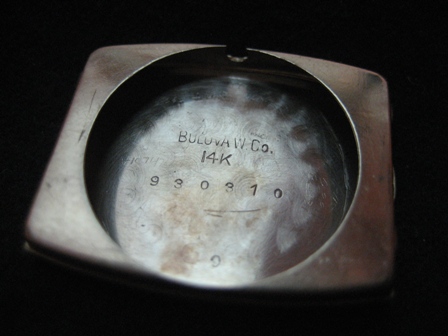I posted this watch a couple of years ago and thought I would give you another look at it.
I bought this watch about 10 years ago from a vintage watch dealer and the story goes (for what it's worth) that he bought it at an estate sale from the Daughter (who was elderly) of a man that worked for Bulova in R&D back in the early days. She believed that her father designed this watch and Bulova never put it in to production.
The case measurements are 37.35mmx26.80mm, it's a good size watch. The 9AN movement has a triangle on it that would date it to 1926, the movement also has a serial #300371.
The back of the dial is stamped 301321ZJ, I wonder if these are the correct hands to go with this dial?
My jeweler tested the Case back and Bezel and it is 14K white and 14K yellow Gold.

Thinking along the same line, if a prototype why the serial number on the case. The calendar watch I have is cased in a non-serial numbered case, it only had 'Bulova Quality'. The other example we have on site has the full suite of serial numbers.
How did we come up with 1926?
Difficult to know if the movement is original to the case.
The watch is a real looker regardless!
I'm sure the year was based on the movement triangle date code. I might be inclined to stay with 1926 actually. My thinking is that the engraving matching the case to the movement means they do go together but solid gold cases don't always conform to what we think is Bulovas case dating regimen. Either way I still want the watch. The suggestion that a prototype should be plated or rolled is, I think backwards. It seems to me that a proto would be engraved and a mold would be struck if it went into production. I have what I believe to be a 1927 Bulova Mercury on the desk in front of me. I base it on 1927 by adverts and movement date code. The case back is very similar to this but has 264917 serial number. It is marked Bulova Watch Co 14 K.
Confirming Dennis, I'm still registered as the next owner? Ha Ha!
